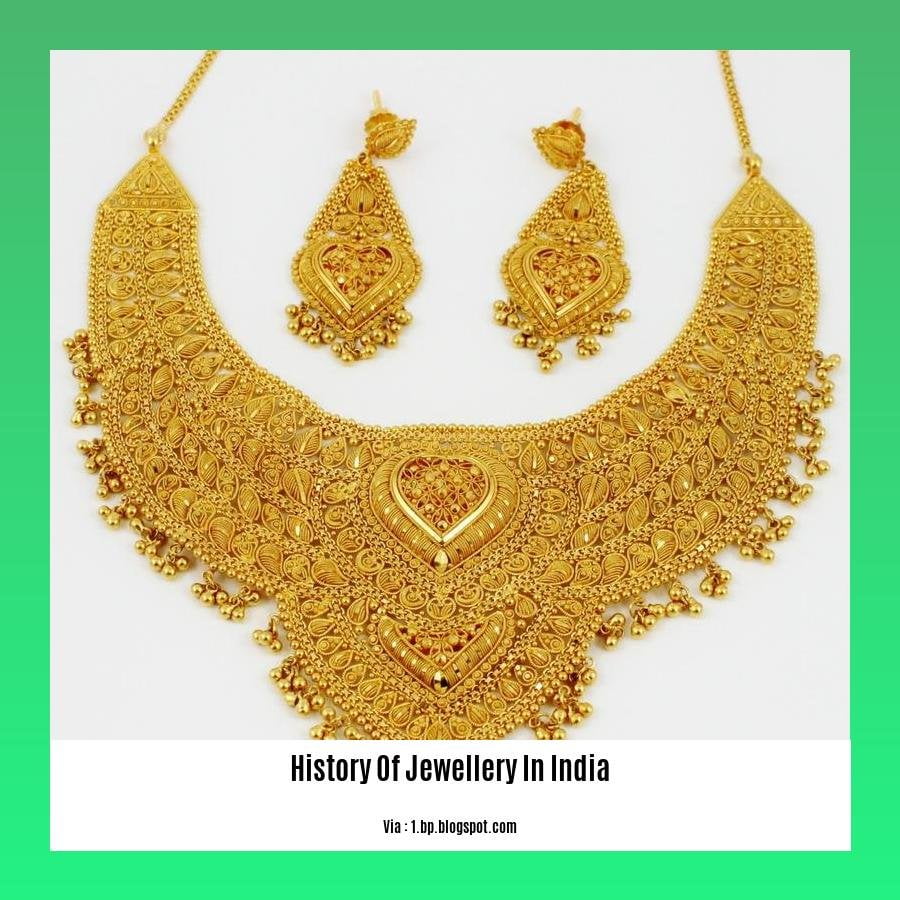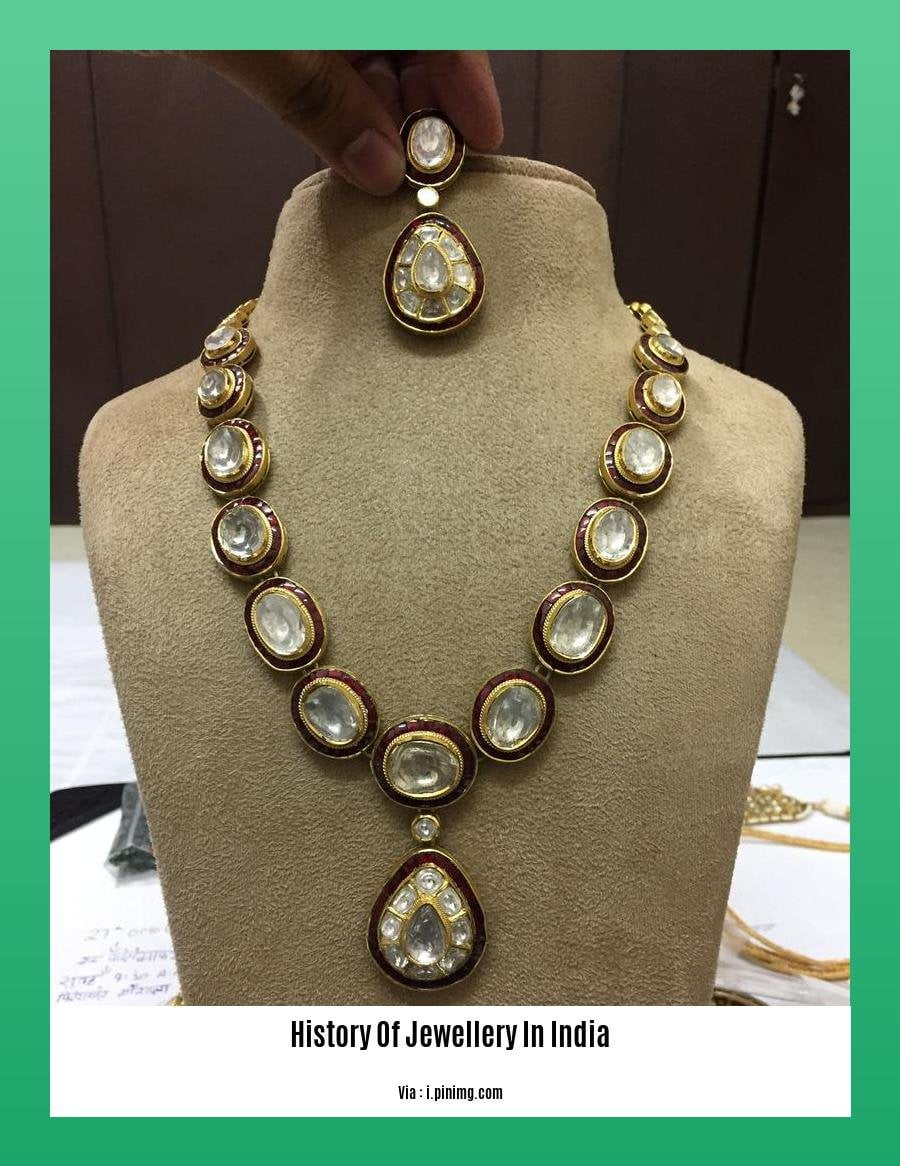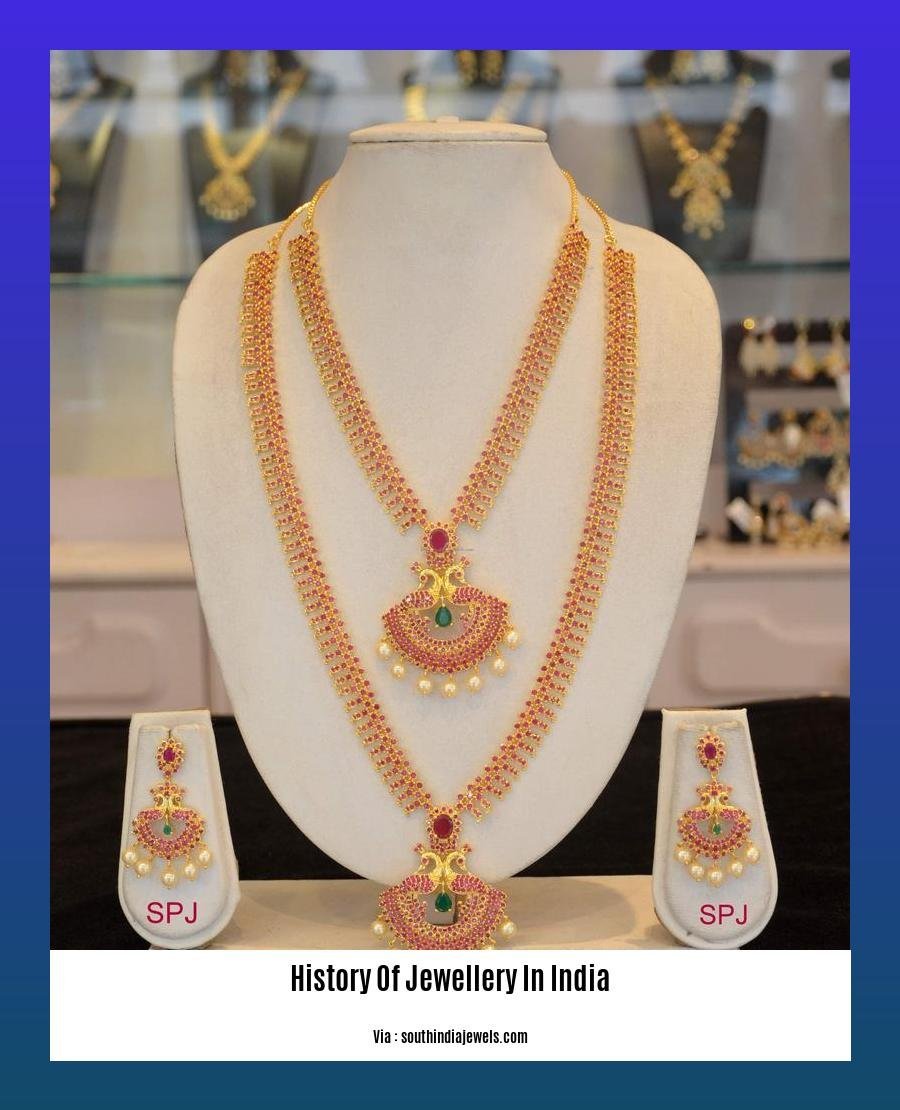Embark on a captivating journey through the annals of Indian jewelry with “Unraveling the Splendid History of Jewellery in India: A Cultural Historian’s Perspective.” Delve into the rich narratives woven into exquisite artifacts, where each piece holds a profound historical significance. Discover the evolution of jewelry designs, materials, and techniques across dynasties and regions, as we unlock the secrets of India’s glittering past.
Key Takeaways:
The history of Indian jewelry dates back 5,000 to 7,000 years, originating in the Indus Valley civilization.
India was a significant producer and exporter of beads during ancient times.
Indian jewelry holds cultural and religious significance, beyond just being an adornment.
Contemporary jewelry trends in India draw inspiration from traditional designs while incorporating modern elements.
Different types of Indian jewelry include Polki, Kundan, Jali, Lac, and Meenakari, each showcasing unique characteristics.
History of Jewellery in India

Embark on a journey through the resplendent history of Indian jewelry, where cultural narratives intertwine with exquisite craftsmanship.
Ancient Roots:
The origins of Indian jewelry can be traced back to the Indus Valley Civilization, thriving around 5,000 years ago. This era witnessed the birth of intricate bead-making techniques, establishing India as a prominent producer and exporter of these adornments.
Symbolism and Spirituality:
Indian jewelry transcends mere embellishment, carrying profound cultural and religious significance. Each piece often holds symbolic meaning, embodying protection, good luck, and divine blessings.
Evolution Through the Ages:
The history of Indian jewelry is a testament to constant evolution, influenced by various dynasties, regions, and cultural exchanges.
- Mughal Era: Mughal emperors left an indelible mark on Indian jewelry, introducing intricate enameling techniques (Meenakari) and incorporating gemstones like rubies and emeralds.
- British Colonial Period: The British Raj brought Western influences, leading to the fusion of traditional designs with European motifs and settings.
- Contemporary Era: Modern-day Indian jewelry strikes a balance between tradition and modernity, incorporating contemporary elements while preserving cultural motifs.
Types of Indian Jewelry:
The diverse landscape of India boasts a wide array of jewelry styles, each with unique characteristics:
- Polki: Exquisite uncut diamonds set in gold, embodying opulence and grandeur.
- Kundan: Precious gemstones meticulously embedded in gold, creating a radiant and elegant effect.
- Jali: Intricate latticework in gold or silver, showcasing craftsmanship and allowing for intricate designs.
- Lac: Vibrant and lightweight jewelry crafted from lac (resin), often adorned with colorful beads and mirrors.
- Meenakari: The art of enameling, where vibrant colors are fused onto metal surfaces, creating captivating patterns.
Conclusion:
The history of Indian jewelry reflects the country’s rich cultural heritage, where each piece holds a story, embodying tradition, artistry, and personal expression.
Learn about the rich history behind jewellery design and trends that have transcended the years and cultures. History of jewellery design.
The history of jewellery making dates back to ancient times, with each era and civilization leaving its unique mark on this art form.
Regional Variations: The history of Indian jewelry is characterized by diverse regional variations, with each region developing its own distinct styles and techniques.
India, a vibrant tapestry of cultures, boasts a rich history of jewelry making that varies greatly from region to region. Each corner of this incredible country has its own unique style, influenced by local traditions, materials, and craftsmanship. Let’s embark on a journey to discover these fascinating regional variations.
North India:
The North, with its Mughal heritage, is renowned for kundan and meenakari jewelry. Kundan involves setting gemstones in pure gold, creating exquisite pieces that shimmer and sparkle. Meenakari, on the other hand, showcases intricate enamel work, adding vibrant hues to gold or silver ornaments.
South India:
In the South, gold dominates jewelry making, and nature serves as a constant muse. Temple jewelry, inspired by intricate temple architecture, is a hallmark of this region. Temple jewelry, inspired by intricate temple architecture, is a hallmark of this region. Gold filigree work, with its delicate lace-like patterns, adds a touch of elegance to South Indian jewelry.
East India:
The East, influenced by Bengal’s rich nawabi culture, is known for its intricate filigree work. Artisans weave gold or silver into delicate lace-like patterns, creating lightweight and airy ornaments. Shola, a unique material derived from a plant, is also commonly used to make lightweight jewelry, particularly for special occasions.
West India:
In the West, the land of vibrant Gujarat, silver takes center stage. Silver jewelry, often adorned with colorful gemstones, is a popular choice for everyday wear. The region is also famous for its lacquer bangles, intricately painted with traditional motifs.
Key Takeaways:
- Regional Variations: Each region of India has its own distinct style and technique of jewelry making, showcasing regional variations.
- North: Kundan and meenakari jewelry are popular, featuring gemstones set in gold and intricate enamel work.
- South: Gold dominates jewelry making, with temple jewelry and gold filigree work as regional specialties.
- East: Intricate filigree work and shola jewelry are popular in the East, influenced by Bengal’s nawabi culture.
- West: Silver jewelry and lacquer bangles are common in the West, with colorful gemstones and traditional motifs adding vibrancy.
Citations:
[1] Exploring Regional Variations in Indian Jewelry Making – Gems of Jaipur: https://gemsofjaipur.net/blogs/news/exploring-regional-variations-in-indian-jewelry-making
[2] History of Indian Jewelry – The Archaeological Box:
Evolution of Designs: Over time, Indian jewelry designs evolved, influenced by cultural interactions, trade, and changing societal norms.

The landscape of Indian jewelry design has undergone astounding transformations throughout history, echoing the evolving tapestry of the nation’s culture, trade, and societal norms. Let’s delve into this fascinating journey:
Ancient Origins
- Indian jewelry traces its lineage back to antiquity, with the Indus Valley civilization, a cradle of civilization in 3300 BCE.
- Early adornments in India comprised natural elements like shells, bones, and stones, reflecting a deep connection with nature.
Mughal Magnificence
- The Mughal Empire, renowned for its opulence and patronage of the arts, indelibly shaped Indian jewelry aesthetics.
- Evolution of Designs: Over time, Indian jewelry designs evolved, influenced by cultural interactions, trade, and changing societal norms.
- Mughals introduced intricate enamel work (Meenakari) and an array of gemstones, such as rubies, emeralds, and diamonds, resulting in exquisite jewelry pieces.
- Mughal jewelry often carried intricate decorative motifs, including floral patterns, calligraphy, and geometric designs, reflecting the era’s artistic sensibilities.
Colonial Influences
- The advent of British rule in India had a significant impact on jewelry design.
- Western influences blended with traditional Indian aesthetics, leading to the incorporation of European motifs and settings into Indian jewelry.
- This fusion resulted in a unique style that showcased both Eastern and Western design elements, creating a distinct aesthetic.
Modern Masterpieces
- Post-Independence, Indian jewelry underwent a revival and resurgence, drawing inspiration from the country’s rich heritage and cultural diversity.
- Contemporary Indian jewelry designers experiment with innovative techniques, combining traditional craftsmanship with modern design sensibilities.
- This fusion of tradition and modernity has given birth to stunning masterpieces that resonate with the global fashion landscape.
Key Takeaways:
- Indian jewelry’s evolution reflects the nation’s rich cultural history, where each period adds a unique layer to its design narrative.
- From ancient natural adornments to Mughal opulence and colonial influences, Indian jewelry has absorbed diverse influences, shaping its ever-evolving aesthetics.
- Today’s Indian jewelry designers skillfully blend tradition and modernity, creating masterpieces that captivate hearts worldwide.
Relevant Sources:
[1] https://www.gemsofjaipur.net/blogs/news/the-evolution-of-indian-jewelry-design-from-traditional-to-modern
[2]
Modern Revival: In recent decades, there has been a revival of interest in traditional Indian jewelry, with designers blending contemporary aesthetics with traditional motifs.
Over the years, the history of Indian jewelry has been a widespread trend that is still being recognized. In recent years, specifically, there has been a revival of interest in traditional Indian jewelry. Today’s designers take inspiration from our past and blend contemporary aesthetics with traditional motifs, giving the jewelry a unique, modern twist. This revival is being driven by several factors:
A Growing Appreciation for Traditional Craftsmanship:
- Artisans are using traditional techniques to create new and innovative pieces that appeal to modern consumers.
The Desire for Unique and One-of-a-Kind Pieces:
- Consumers are increasingly looking for jewelry that is not mass-produced, and traditional Indian jewelry fits this need.
The Growing Popularity of Indian Culture:
Indian culture is becoming increasingly popular around the world, and this has led to a greater demand for traditional Indian jewelry.
Designers have been responding to this demand by creating new collections that combine traditional and modern elements to appeal to a wider audience.
Designers are also using new materials and techniques to create contemporary pieces.
Examples of Modern Revival Jewelry:
Some examples of modern revival jewelry include:
Jhumkas (earrings) with a modern twist, such as those with oxidized silver or colored gemstones.
Chokers with a contemporary design, such as those with geometric patterns or mixed metals.
Bangles with a modern edge, such as those with hammered textures or unusual shapes.
Key Takeaways:
The revival of interest in traditional Indian jewelry is being driven by a number of factors, including a resurgence of interest in traditional handicrafts, the desire for unique and one-of-a-kind pieces, and the growing popularity of Indian culture.
Contemporary designers are meeting this demand by creating new collections that blend traditional and modern elements to appeal to a wider audience.
Modern revival jewelry offers a unique and stylish way to express your love for Indian culture.
Citation:
History, Origin, and Evolution of Indian Jewelry
Exploring Regional Variations in Indian Jewelry Making
FAQ
Q1: What makes Indian jewelry unique in the world?
A1: Indian jewelry stands out globally due to its exceptional craftsmanship, reflecting a rich amalgamation of cultural and religious influences. It showcases intricate designs, a play of colors, and the use of precious stones and metals, making each piece a masterpiece.
Q2: Which era is considered the golden age of Indian jewelry?
A2: The Mughal era, spanning the 16th to 19th centuries, is widely regarded as the golden age of Indian jewelry. This period witnessed an explosion of intricate designs, the use of gemstones, and the patronage of skilled artisans, leading to the creation of some of the finest jewelry pieces in Indian history.
Q3: How has Indian jewelry been influenced by different regions and cultures?
A3: Indian jewelry exhibits a diverse range of styles, reflecting the country’s vast regional and cultural diversity. The designs and techniques vary across regions, with each state or community showcasing its unique heritage. For instance, the Kundan jewelry from Rajasthan is known for its intricate gold work and gemstones, while the Meenakari jewelry from Jaipur is famous for its enamel work.
Q4: What are some of the symbolic meanings associated with Indian jewelry?
A4: Indian jewelry carries deep symbolic meanings, often tied to religious beliefs, cultural customs, and personal expressions. It can signify love, prosperity, protection, and various other emotions or aspirations. For example, the Mangalsutra, a necklace worn by married women, symbolizes their marital status, while the Nazar battu, an amulet, is believed to ward off evil.
Q5: How has the significance of Indian jewelry evolved over time?
A5: The significance of Indian jewelry has evolved over the centuries, adapting to changing social and cultural norms. In ancient times, jewelry held religious and cultural significance, serving as a form of adornment and a symbol of wealth and status. Today, while it still retains its traditional importance, Indian jewelry has also become a fashion statement, allowing individuals to express their personal style and make a statement.
















